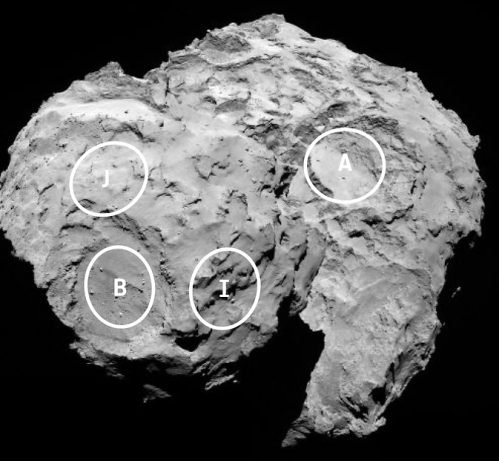
(This annotated image depicts four of the five potential landing sites for Rosetta’s Philae lander – Photo Credit: ESA/Rosetta/MPS for OSIRIS Team et al)
Using detailed information collected by the Rosetta spacecraft during its first two weeks orbiting Comet 67P/Churyumov-Gerasimenko, the European Space Agency have identified five candidate landing sites for the robotic Philae lander which will make history and descend from Rosetta and land on the comet’s nucleus in November.
Rosetta rendezvoused with comet 67P on August 6th and since then, the ESA have been busy selecting a safe location for Philae’s touchdown, but choosing the right landing site is a complex process.
For each possible zone, a number of questions had to be asked: Will the lander be able to maintain regular communications with Rosetta? How common are surface hazards such as large boulders, deep crevasses or steep slopes? Is there sufficient illumination for scientific operations and enough sunlight to recharge the lander’s batteries beyond its initial 64-hour lifetime without causing overheating?
 (Rosetta’s NAVCAM captured this photograph at a distance of about 83km from comet 67P/C-G. The comet nucleus is about 4 km across – Photo Credit: ESA/Rosetta et al)
(Rosetta’s NAVCAM captured this photograph at a distance of about 83km from comet 67P/C-G. The comet nucleus is about 4 km across – Photo Credit: ESA/Rosetta et al)
“This is the first time landing sites on a comet have been considered,” said Stephan Ulamec, Philae Lander Manager at the German Aerospace Center.
“The candidate sites that we want to follow up for further analysis are thought to be technically feasible on the basis of a preliminary analysis of flight dynamics and other key issues – for example, they all provide at least six hours of daylight per comet rotation and offer some flat terrain. Of course, every site has the potential for unique scientific discoveries” he added.

(This annotated image depicts two of the five potential landing sites for the Philae lander – Photo Credit: ESA/Rosetta/MPS for OSIRIS Team et al)
After a lot of deliberation, five potential landing sites were selected and each assigned a letter. Three sites (B, I and J) are located on the smaller of the comet’s two lobes while two sites (A and C) are located on the larger lobe.
“The process of selecting a landing site is extremely complex and dynamic; as we get closer to the comet, we will see more and more details, which will influence the final decision on where and when we can land,” said Fred Jansen, Rosetta’s mission manager.
“We had to complete our preliminary analysis on candidate sites very quickly after arriving at the comet, and now we have just a few more weeks to determine the primary site. The clock is ticking and we now have to meet the challenge to pick the best possible landing site” added Jansen.
 (Two other possible landing sites – Photo Credit: ESA/Rosetta/MPS for OSIRIS Team et al)
(Two other possible landing sites – Photo Credit: ESA/Rosetta/MPS for OSIRIS Team et al)
The next step in selecting the final, primary landing site will be conducting a comprehensive analysis of each of the candidate sites to determine possible orbital and operational strategies that could be used for Rosetta to deliver the lander to any of them.
Rosetta will then move to within 31 miles (50 kilometers) of the comet, allowing a more detailed study of the proposed landing sites. By September 14, the five candidate sites will have been assessed and ranked, leading to the selection of a primary landing site. A fully detailed strategy for the landing operations at the selected site will be developed, along with a backup.
 (Artist’s illustration of Philae’s touchdown – Photo Credit: ESA)
(Artist’s illustration of Philae’s touchdown – Photo Credit: ESA)
Philae’s landing is expected to take place in mid-November when the comet is about 280 million miles (450 million kilometers) from the sun. This will be before activity on the comet reaches levels that might jeopardize the safe and accurate deployment of Philae to the comet’s surface, and before surface material is modified by this cometary activity.
The comet is on a 6.5-year orbit around the Sun and today is 522 million km from it. At their closest approach on 13 August 2015, just under a year from now, the comet and Rosetta will be 185 million km from the Sun, meaning an eightfold increase in the light received from the Sun.
Rosetta and its scientific instruments will watch how the comet evolves as heating by the Sun increases, observing how its coma develops and how the surface changes over time.
At the same time, Philae and its instruments will be tasked with making complementary in situ measurements at the comet’s surface. The lander and orbiter will work together using the CONSERT experiment to send and detect radio waves through the comet’s interior, in order to characterise its internal structure.
You can follow Rosetta and Philae on Twitter, as well as on the ESA’s blog.